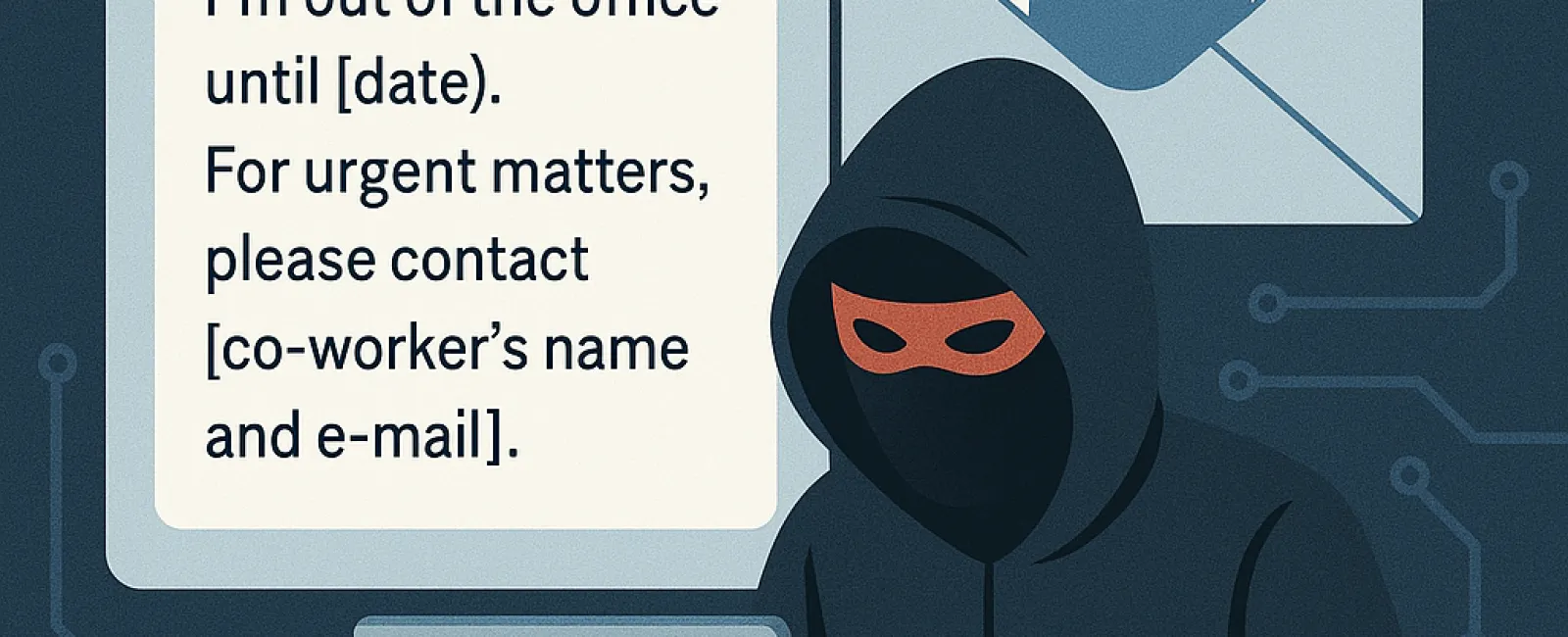June 16, 2025
You set it. You forget it. And just like that, while you're packing for vacation, your inbox starts automatically sending:
"Hi there! I'm out of the office until [date]. For urgent matters, please contact [coworker's name and e-mail]."
Sounds harmless, right? Convenient, even.
But that's exactly what cybercriminals want to see.
Your auto-reply—the simple message meant to keep things organized and running smoothly—is actually a treasure trove of information for bad actors looking for an easy way in.
Let's break it down. A typical out-of-office message might include:
- Your name and title
- Dates you're unavailable
- Alternate contacts (with their e-mail addresses)
- Internal team structures
- Even reasons why you're away ("I'm at a conference in Chicago…")
This gives cybercriminals two key advantages:
1. Timing: They know you're away and less likely to catch suspicious activity.
2. Targeting: They know who to impersonate and who to target with scams.
This sets the stage for a perfect phishing or business e-mail compromise (BEC) attack.
How The Scam Usually Plays Out
Step 1: Your auto-reply message goes out.
Step 2: A hacker uses it to impersonate you or the alternate contact you provided.
Step 3: They send an "urgent" e-mail requesting a wire transfer, password, or sensitive document.
Step 4: Your coworker, surprised, assumes the request is legitimate.
Step 5: You return from vacation to find that someone sent $45,000 to "a vendor."
This happens more often than you might think and is especially risky for businesses with frequent travelers.
If your company has staff who travel often, particularly executives or sales teams, and someone else manages communications in their absence (like a personal assistant or office admin), this creates ideal conditions for cybercriminals:
- The admin handles e-mails from multiple people
- They're accustomed to managing payments, documents, or sensitive requests
- They work quickly, trusting the people they believe they're hearing from
One well-crafted fake e-mail can slip through and suddenly your business faces a costly breach or fraud incident.
How To Protect Your Business From Auto-Reply Exploits
The answer isn't to stop using out-of-office replies entirely—it's to use them carefully and add protections. Here are some tips:
1. Keep It Vague
Avoid detailed schedules. Don't name who's covering for you unless absolutely necessary.
Example: "I'm currently out of the office and will respond when I return. For immediate assistance, please contact our main office at [main contact info]."
2. Train Your Team
Make sure employees know:
- Never act on urgent requests involving money or sensitive info based on e-mail alone
- Always verify unusual requests through a second channel (like a phone call)
3. Implement E-mail Security Tools
Use advanced filters, anti-spoofing measures, and domain protection to reduce impersonation attacks reaching your inbox.
4. Use MFA Everywhere
Enable multifactor authentication on all e-mail accounts. Even if a password is stolen, MFA blocks unauthorized access.
5. Work With An IT Partner Who Monitors Activity
A proactive IT and cybersecurity partner can spot login attempts, phishing attacks, and unusual behavior before damage occurs.
Want To Vacation Without Becoming A Hacker's Next Target?
We help businesses build cybersecurity systems that keep you safe—even when your team is out of the office.
Click Here Or Give Us A Call At 435-313-8132 To Book A FREE 10-Minute Conversation.
We'll
check your systems for vulnerabilities and show you how to lock down the risks,
so you can actually enjoy that vacation without worrying about your inbox
betraying you.



